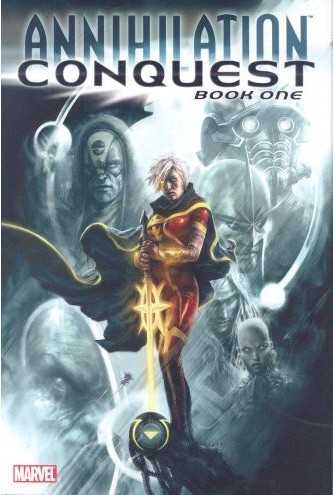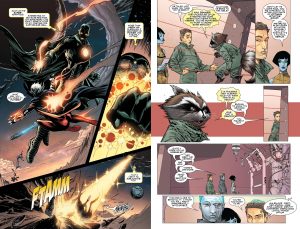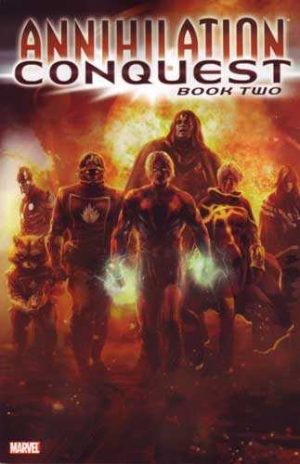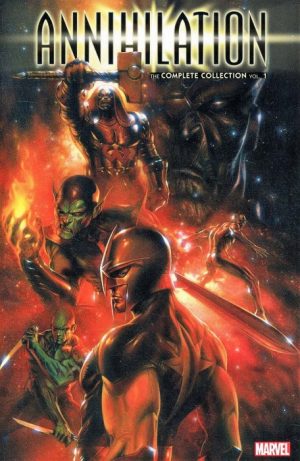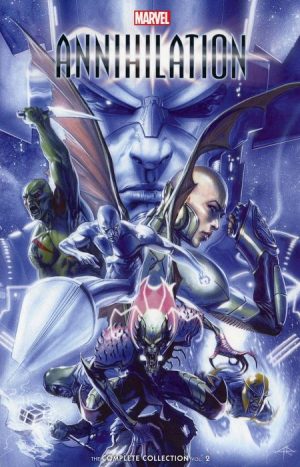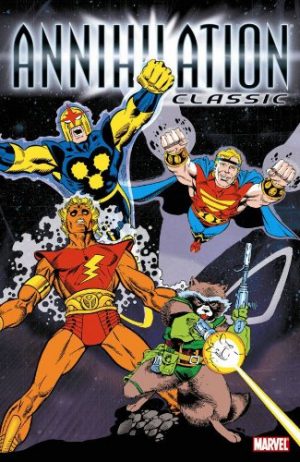Review by Ian Keogh
Annihilation Conquest follows the very successful Annihilation, looking at how that event re-shaped the Marvel universe beyond Earth. Empires have been shattered, planets destroyed or devastated, and almost everywhere rebuilding is a priority. The structure is similar to Annihilation, with a prologue introducing a situation that rapidly spreads, followed up by spotlighting various characters in different locations coping with the result. This time it’s Dan Abnett and Andy Lanning setting everything in motion, introducing the Phalanx, a techno-organic race who’re taking over ailing civilisations and assimilating them into a central hive mind, with other creators feeding into that plot.
Annihilation reconfigured Quasar, introducing a new character of that name, in essence a well intentioned novice with incredibly powerful wrist devices. Kree warrior Phyla-Val has a lot to live up to, her brother a hero who died saving the universe, and is tasked with a mission to find the Kree saviour without knowing who it might be. In this segment Christos Gage and Mike Lilly deliver a comics equivalent of the fantasy quest, with Quasar growing into her new status via faltering steps, much self-doubt and a relationship with her mentor Moondragon, who’s wearing a new personality. It’s unconvincing. As an abrasive, single-minded character she had a novelty, but as a caring, lovestruck advisor Moondragon is bland. The mistake is not the same sex relationship, but its unconvincing and sometimes simpering nature, which is as nothing compared to Moondragon’s next ridiculous transformation, and the clichéd way Quasar eventually wins through. The saving of this section is Lilly’s grainy art. He’s not the best at human figures, but the aliens and locations he designs looks great, and he has a fine eye for a pin-up composition.
Nothing ever really came of the new Quasar character, her powers eventually as ill-defined and all-purpose as those of her predecessor, but Keith Giffen’s continuing rehabilitation of Star-Lord resulted in the personality now seen on movie screens in the Guardians of the Galaxy. Rocket Raccoon and Groot also form part of a squad sent on a suicide mission, their purpose being to destroy the artificial race’s replication technology, and by the end the essence of the Guardians has been set-up, even if Groot actually speaks comprehensibly. Giffen has a lot of fun with essentially mismatched characters having to scrub along in an ensemble piece, and his plot serves up several ingenious twists, not least the reversal opening the final chapter. The art’s good as well, with Timothy Green II taking the Phalanx design and morphing the race into something more chilling, and effectively merging a cast that’s extremely visually mismatched.
Completing a trio of good artists is Mike Perkins on the prologue, his style more naturalistic than the others, but his chapter features the most humans. The intriguing nature of the prologue coupled with decent art and the Star-Lord segment tips the balance of the book into the plus column, and we see how others fare against the Phalanx in Book Two. Alternatively, there’s a hardcover Omnibus version merging both books and featuring chapters not included here revealing what occurred before Nova’s late intervention.
